Tuesday, November 30, 2010
How Connecting Your LinkedIn Contacts Builds Social Influence
http://www.socialmediaexaminer.com/how-connecting-your-linkedin-contacts-builds-social-influence/By Stephanie Sammons
Published November 18, 2010
social media how toAre you wondering how to leverage your presence on LinkedIn to build social influence?
Regularly updating your status, joining and participating in groups and answering questions is just the start.
There are also a number of ways to build deeper relationships with your connections on LinkedIn. I’m going to ask you to shift your thinking and consider the following:
Spend some time on LinkedIn connecting your contacts.
If you truly want to build social influence with your connections and become more valuable to them, dedicating time to strategically helping others can elevate your “social” status.
People want to be connected with a connector! Connectors are considered valuable resources because they’re genuinely interested and engaged in helping others succeed.
Working to connect your connections on LinkedIn not only helps you become a more influential person, you’ll also benefit from triggering the rule of reciprocity. Essentially, the rule of reciprocity states that when you do something that can benefit someone else, you’re making a psychological deposit with that person and he or she will feel obligated to repay the favor.
LinkedIn is the perfect environment in which to put the rule of reciprocity to use.
Why? Mostly, the network is transparent. LinkedIn members are sharing not only information about their professional background, skills, and experience, but they’re also sharing personal hobbies and interests. Never before have you been able to see all of these details about your professional network laid out right in front of you. The power of the LinkedIn network provides a compelling opportunity to grow your business.
A 3-Step Process for Connecting Your Connections on LinkedIn
#1: Analyze Your First-Degree Connections
Here’s a big-picture exercise that will get you thinking about who you know, what’s important to the people you know and who should know one other within your LinkedIn contacts.
Go to the Advanced People Search tool within LinkedIn. Under the “Relationship” section on the left, filter for your first-degree connections only (see image below).
This will bring up a list of all of your first-degree connections. Make sure to choose “Expanded View” to see more details about your connections within this search. A free LinkedIn account will show you up to 100 profile results per search.
The Advanced Search tool is located at the top right of your profile page.
Filter for first-degree connections.
Once you’ve pulled up the search results, scroll slowly through your entire list of first-degree connections, looking closely at faces and titles. Simply spending some time scanning through this list of connections can help trigger and uncover common ground among your connections that you may not have thought about. Take notes as you go through this process.
Next, identify your 10 best business relationships from this list and jot them down. Also add the 10 most influential people you’re connected with (there may be some overlap). Now it’s time to analyze your first-degree list of best relationships and top influencers.
Are there similar personality types? Do any of the career and business paths of your connections intersect or have complementary characteristics (i.e., could you connect an executive leadership coach with an executive, or an entrepreneur with a venture capitalist)? Whom can they benefit from knowing, being connected to, or working with on your list? Do any of these individuals live in the same geographic area? Do any of them have similar personal interests or belong to the same LinkedIn Groups or outside organizations?
Unfortunately there is no quick way to conduct this in-depth search other than to view the profiles manually and identify all the potential links. However, it will be well worth your time! Bringing together your best relationships with your top influencers is a very powerful exercise and you should get to know as much as you can about these individuals.
An example in action—connecting the dots:
John owns his own technology firm and Sam is a financial professional. They live in different states but they’re my first-degree connections. Through my relationships with these two individuals I’ve learned that they’re both Ironman triathletes who blog about their triathlon training and experiences, and they both strive for their personal best in business and in life. In my mind, these two must know each other and there could certainly be an opportunity for them to do business together as well.
Both John and Sam were extremely grateful for the introduction and were thrilled to meet a like-minded acquaintance with a passion for competing in triathlons. In this example, I was able to come up with this mutually beneficial connection by simply scanning through my first-degree connections and concentrating on what I know about each person, both personally and professionally. It’s all about connecting the dots!
#2: Filter Your First-Degree Search by Geography, Industry and/or Keywords
This time, start your Advanced LinkedIn search for first-degree connections, but run some filters. We’ll start by filtering your search results for geography and get more specific from there.
Using the Geography filter, choose the location where you have the most connections. Now study these profiles and go through the same questions listed in exercise #1. Who in this group of connections should be connected to one other and why? Can you see any professional common threads among those professionals who live in your area?
Now let’s narrow it down further and apply some filters for industry. First, view your connections who work in the same industries. Are there any opportunities for these individuals to benefit from networking with industry peers? Next, check the boxes for a handful of industries that could be complementary (i.e., financial and legal, marketing and design). Are there opportunities to connect any of these individuals where it could be mutually beneficial from a business standpoint?
Finally, let’s narrow it down even further by applying a keyword filter that describes a hobby or interest. The strongest ties are those that center on personal interests. The Keyword search box will be at the top left of your Advanced Search screen. If you need help coming up with a keyword for personal interests, look at your own interests that you’ve listed on your profile and use one of those words or phrases. What are you interested in and passionate about? What are your best connections interested in and passionate about?
An example in action—personal interests are powerful:
I’ve got about 130 professional LinkedIn connections in Dallas where I live. After I’ve run the first two filters (location and industry), I’ve got a list of 37 people whom I feel would benefit from being connected on a professional level. I then decided to run a keyword filter for the word “golf,” and that narrowed it down to 4 individuals! Now I’ve identified 4 of my connections who all live in my area, work in similar or complementary industries and enjoy golfing. I can decide from here whom I want to connect, and even connect the entire group of people through a golf outing!
Filter your searches to find common ground among your first-degree connections.
Go through this process numerous times with your first-degree connections, but reverse and play around with the order of your filters.
For example, start with a keyword based on one of your interests, and then filter for geography, followed by industry. You can certainly connect others across the country as well. There are really no rules here other than the more common ground you can identify among the connections you connect, the more relevant and meaningful that introduction will be for both parties.
#3: Send Both Connections a Private Message
Before you utilize the LinkedIn introduction tool, I strongly suggest you send a private message to each of the individuals you’re going to be connecting. First you’ll need to decide who’ll be the person you introduce and who’ll receive the introduction. Send a private message first to the person you’ll introduce. Use something like the following to let him or her know what to expect:
“Hi Sam, I know someone whom I think you would really enjoy meeting and we are also connected here on LinkedIn. His name is John ______ and he owns a technology company here in town. I realized that both of you are passionate about triathlons and even do some blogging on the subject. I wanted to introduce the two of you because you seem to have a lot in common, and you’re both here in Dallas! I will be sending an official LinkedIn introduction over to him shortly to introduce the two of you and you can take it from there. Let me know how it goes! Hope business is going well and let’s get together soon!”
Warm regards,
Stephanie Sammons
For the person who’ll be receiving the introduction, send him or her a private message as well as notification that your introduction will be coming soon. Always send these private messages first to make it clear to both parties what you’re trying to accomplish, otherwise it can be confusing.
Once you’ve sent the private messages, you can send over the official LinkedIn introduction. You can access the link entitled “Make an Introduction” from your connection’s profile.
LinkedIn makes it simple for you to introduce others.
The best way to ensure that these new connections you’re creating on LinkedIn will evolve into potential relationships is to do the work up front, and uncover all of the potential intersecting points or commonalities with your first-degree connections. The more people have in common—especially around personal interests—the more likely a new relationship will develop and thrive! You’ll be appreciated and respected for taking the time to connect the dots and piece these introductions together, and most importantly, you’ll build significant social influence!
It takes work to be a connector, and the benefits may not be immediately measurable. Long-term, however, you’ll reap the rewards in ways that you may not even be able to imagine today. Not only will you become a more valuable and influential person to your existing connections, you’ll open the door for new connections and introductions for yourself.
Have you tried connecting people on LinkedIn? Do you have any tips to add? Please share your story in the comments box below.
Published November 18, 2010
social media how toAre you wondering how to leverage your presence on LinkedIn to build social influence?
Regularly updating your status, joining and participating in groups and answering questions is just the start.
There are also a number of ways to build deeper relationships with your connections on LinkedIn. I’m going to ask you to shift your thinking and consider the following:
Spend some time on LinkedIn connecting your contacts.
If you truly want to build social influence with your connections and become more valuable to them, dedicating time to strategically helping others can elevate your “social” status.
People want to be connected with a connector! Connectors are considered valuable resources because they’re genuinely interested and engaged in helping others succeed.
Working to connect your connections on LinkedIn not only helps you become a more influential person, you’ll also benefit from triggering the rule of reciprocity. Essentially, the rule of reciprocity states that when you do something that can benefit someone else, you’re making a psychological deposit with that person and he or she will feel obligated to repay the favor.
LinkedIn is the perfect environment in which to put the rule of reciprocity to use.
Why? Mostly, the network is transparent. LinkedIn members are sharing not only information about their professional background, skills, and experience, but they’re also sharing personal hobbies and interests. Never before have you been able to see all of these details about your professional network laid out right in front of you. The power of the LinkedIn network provides a compelling opportunity to grow your business.
A 3-Step Process for Connecting Your Connections on LinkedIn
#1: Analyze Your First-Degree Connections
Here’s a big-picture exercise that will get you thinking about who you know, what’s important to the people you know and who should know one other within your LinkedIn contacts.
Go to the Advanced People Search tool within LinkedIn. Under the “Relationship” section on the left, filter for your first-degree connections only (see image below).
This will bring up a list of all of your first-degree connections. Make sure to choose “Expanded View” to see more details about your connections within this search. A free LinkedIn account will show you up to 100 profile results per search.
The Advanced Search tool is located at the top right of your profile page.
Filter for first-degree connections.
Once you’ve pulled up the search results, scroll slowly through your entire list of first-degree connections, looking closely at faces and titles. Simply spending some time scanning through this list of connections can help trigger and uncover common ground among your connections that you may not have thought about. Take notes as you go through this process.
Next, identify your 10 best business relationships from this list and jot them down. Also add the 10 most influential people you’re connected with (there may be some overlap). Now it’s time to analyze your first-degree list of best relationships and top influencers.
Are there similar personality types? Do any of the career and business paths of your connections intersect or have complementary characteristics (i.e., could you connect an executive leadership coach with an executive, or an entrepreneur with a venture capitalist)? Whom can they benefit from knowing, being connected to, or working with on your list? Do any of these individuals live in the same geographic area? Do any of them have similar personal interests or belong to the same LinkedIn Groups or outside organizations?
Unfortunately there is no quick way to conduct this in-depth search other than to view the profiles manually and identify all the potential links. However, it will be well worth your time! Bringing together your best relationships with your top influencers is a very powerful exercise and you should get to know as much as you can about these individuals.
An example in action—connecting the dots:
John owns his own technology firm and Sam is a financial professional. They live in different states but they’re my first-degree connections. Through my relationships with these two individuals I’ve learned that they’re both Ironman triathletes who blog about their triathlon training and experiences, and they both strive for their personal best in business and in life. In my mind, these two must know each other and there could certainly be an opportunity for them to do business together as well.
Both John and Sam were extremely grateful for the introduction and were thrilled to meet a like-minded acquaintance with a passion for competing in triathlons. In this example, I was able to come up with this mutually beneficial connection by simply scanning through my first-degree connections and concentrating on what I know about each person, both personally and professionally. It’s all about connecting the dots!
#2: Filter Your First-Degree Search by Geography, Industry and/or Keywords
This time, start your Advanced LinkedIn search for first-degree connections, but run some filters. We’ll start by filtering your search results for geography and get more specific from there.
Using the Geography filter, choose the location where you have the most connections. Now study these profiles and go through the same questions listed in exercise #1. Who in this group of connections should be connected to one other and why? Can you see any professional common threads among those professionals who live in your area?
Now let’s narrow it down further and apply some filters for industry. First, view your connections who work in the same industries. Are there any opportunities for these individuals to benefit from networking with industry peers? Next, check the boxes for a handful of industries that could be complementary (i.e., financial and legal, marketing and design). Are there opportunities to connect any of these individuals where it could be mutually beneficial from a business standpoint?
Finally, let’s narrow it down even further by applying a keyword filter that describes a hobby or interest. The strongest ties are those that center on personal interests. The Keyword search box will be at the top left of your Advanced Search screen. If you need help coming up with a keyword for personal interests, look at your own interests that you’ve listed on your profile and use one of those words or phrases. What are you interested in and passionate about? What are your best connections interested in and passionate about?
An example in action—personal interests are powerful:
I’ve got about 130 professional LinkedIn connections in Dallas where I live. After I’ve run the first two filters (location and industry), I’ve got a list of 37 people whom I feel would benefit from being connected on a professional level. I then decided to run a keyword filter for the word “golf,” and that narrowed it down to 4 individuals! Now I’ve identified 4 of my connections who all live in my area, work in similar or complementary industries and enjoy golfing. I can decide from here whom I want to connect, and even connect the entire group of people through a golf outing!
Filter your searches to find common ground among your first-degree connections.
Go through this process numerous times with your first-degree connections, but reverse and play around with the order of your filters.
For example, start with a keyword based on one of your interests, and then filter for geography, followed by industry. You can certainly connect others across the country as well. There are really no rules here other than the more common ground you can identify among the connections you connect, the more relevant and meaningful that introduction will be for both parties.
#3: Send Both Connections a Private Message
Before you utilize the LinkedIn introduction tool, I strongly suggest you send a private message to each of the individuals you’re going to be connecting. First you’ll need to decide who’ll be the person you introduce and who’ll receive the introduction. Send a private message first to the person you’ll introduce. Use something like the following to let him or her know what to expect:
“Hi Sam, I know someone whom I think you would really enjoy meeting and we are also connected here on LinkedIn. His name is John ______ and he owns a technology company here in town. I realized that both of you are passionate about triathlons and even do some blogging on the subject. I wanted to introduce the two of you because you seem to have a lot in common, and you’re both here in Dallas! I will be sending an official LinkedIn introduction over to him shortly to introduce the two of you and you can take it from there. Let me know how it goes! Hope business is going well and let’s get together soon!”
Warm regards,
Stephanie Sammons
For the person who’ll be receiving the introduction, send him or her a private message as well as notification that your introduction will be coming soon. Always send these private messages first to make it clear to both parties what you’re trying to accomplish, otherwise it can be confusing.
Once you’ve sent the private messages, you can send over the official LinkedIn introduction. You can access the link entitled “Make an Introduction” from your connection’s profile.
LinkedIn makes it simple for you to introduce others.
The best way to ensure that these new connections you’re creating on LinkedIn will evolve into potential relationships is to do the work up front, and uncover all of the potential intersecting points or commonalities with your first-degree connections. The more people have in common—especially around personal interests—the more likely a new relationship will develop and thrive! You’ll be appreciated and respected for taking the time to connect the dots and piece these introductions together, and most importantly, you’ll build significant social influence!
It takes work to be a connector, and the benefits may not be immediately measurable. Long-term, however, you’ll reap the rewards in ways that you may not even be able to imagine today. Not only will you become a more valuable and influential person to your existing connections, you’ll open the door for new connections and introductions for yourself.
Have you tried connecting people on LinkedIn? Do you have any tips to add? Please share your story in the comments box below.
8 Social Media Trends Impacting Businesses
 As businesses continue to integrate social media and become more confident and comfortable with social media tools and platforms, we’re starting to see a change in social media usage. A new study reveals what’s changing with social media.
As businesses continue to integrate social media and become more confident and comfortable with social media tools and platforms, we’re starting to see a change in social media usage. A new study reveals what’s changing with social media.SmartBrief recently partnered with Summus Limited to survey more than 6,000 of its readers across a variety of industries.
They benchmarked and measured the state of social media usage among businesspeople. The data identified eight prevalent trends that give great insight into the social media behaviors, beliefs and challenges of the majority of businesses today.
#1: Companies Are Still New to Social Media
Most companies (66.5%) have adopted social media in the past 18 months. About half of the companies reported they’ve only been using social media for about a year and about 20% reported they’ve adopted social media practices in the past 13 to 18 months.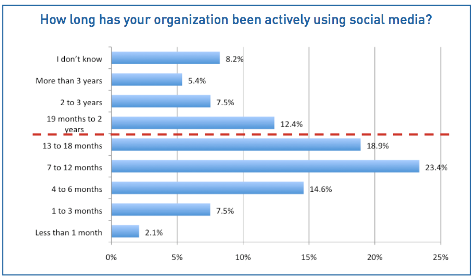
The graph above is a great reminder that most businesses are still very new to the social media arena.
#2: Businesses Focus in on the “Big 5″
Companies are focusing their energies on Facebook, Twitter, LinkedIn, YouTube and blogs. Data suggests that companies focus their time and efforts on the “big 5″ because they’re able to find their customers there.Unfortunately companies may be missing out on valuable niche groups by not extending their reach to the less-popular social sites. Flickr, for example, has a large audience even though it’s not as popular as Facebook or YouTube.
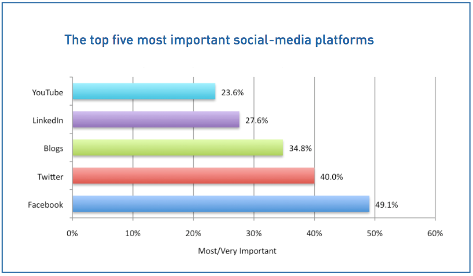
Based on the graph above, Facebook is the leader in social media platforms; however, Twitter is close behind in the minds of business professionals.
#3: The 2-Year Confidence Mark
It takes time for companies to incorporate social media effectively. The data identified a 2-year mark where businesses begin to gain confidence in their social media activity.More than 25% of the companies using social media for 2 or more years say the tools and platforms have been fully integrated into their business model. In addition, more than 50% say they have a well-developed or fully developed social media strategy.
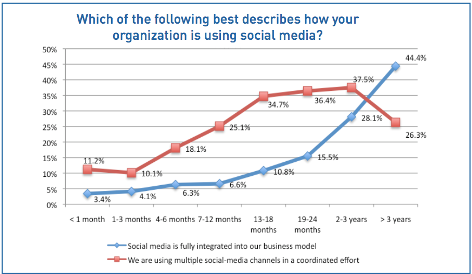
Note the 2-year mark in the graph above. This is where the majority of companies start feeling more confident in their social media strategies.
#4: Companies Are Broadcasting Versus Connecting
Brand-building is currently the primary purpose for business social media usage. However, the research showed that most companies are using social media to broadcast information versus using it for two-way communication.This is unfortunate. Many companies are missing the opportunity to build stronger relationships by listening to their clients or customers, instead of doing all the talking.
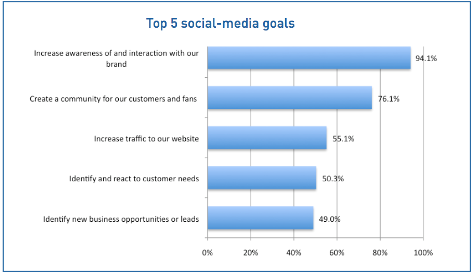
As indicated in the chart above, the most popular social media goal among the respondents was to "increase awareness and interaction with our brand."
#5: Businesses Turn to Internal Sources for Social Media Support
Communications, advertising and marketing agencies are the leading adopters of social media. However, an interesting finding of the study showed that agencies are not the preferred source for social media support. Most of the companies surveyed have opted to create and execute their social media strategy using internal resources.The marketing, communications and advertising agencies were the clear early adopters of social media, but businesses have been reluctant to turn to these agencies for social media support.
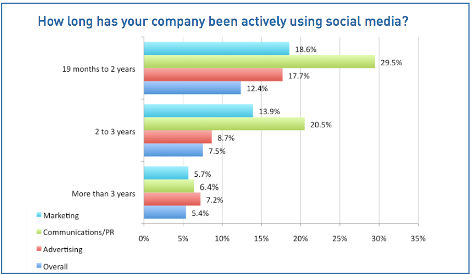
The resistance to look to an agency for support may be a partial reason for the 2-year "ramp-up period" highlighted in the chart above.
#6: Social Media Adoption Obstacles
Lack of management support and confidentiality concerns top the list of obstacles to social media adoption. There was a clear lack of management support for those companies who have not yet adopted social media. 33% of the respondents pointed out they weren’t the decision-makers and 14.7% stated “management resistance” as an obstacle to social media adoption. To add to this, 33.1% pointed to “confidentially issues” as a reason for not adopting social media.As we’ve seen in numerous studies this last year, companies are still struggling with employee social media usage and how to manage it internally.
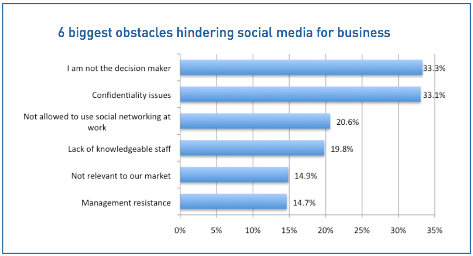
In this chart, it's interesting how 33.3% of the respondents saw their lack of decision-making ability as an obstacle for social media integration in their business. Likely, the majority of the people responsible for social media management are not in a traditional management role.
#7: Lack of Social Media Measurement
Less than 15% of the businesses using social media are measuring return on investment. Over 33% are not measuring return on investment at all. It seems that many businesses struggle with identifying what to measure, how to measure and how to interpret the data when they are able to gather results.Among those businesses that are measuring their social media activity, the focus is on usage and incoming traffic. Interestingly, most are not using traditional business metrics.
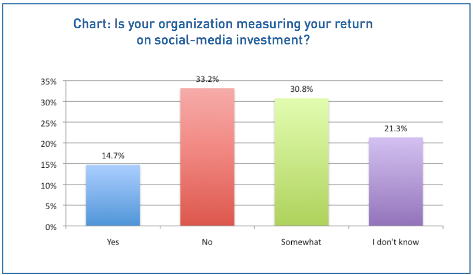
As this chart shows, only 14.7% of respondents answered "yes" to the question "Is your organization measuring your return on social media investment?" This shows that businesses know they should be using social media, but they don't necessarily understand why.
#8: Companies Lack Confidence in Their Social Media Strategy
While 60% of respondents say their companies are using social media, there’s low confidence in their social media strategies. One of the most interesting findings in this report was how the respondents rated their social media strategies. Only 14.2% described their strategies as “very effective,” while a low 7.3% described them as “very revenue generating” on average.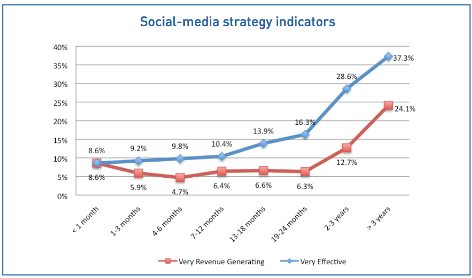
Based on this graph, it's clear that most of the companies surveyed didn't have confidence in their social media strategy.
The full “State of Social Media for Business 2010” is available here from SmartBrief.
Now it’s your turn. Where does your company stand versus the social media benchmarks mentioned above? Are you confident in your social media strategy? Share your experience and comments in the box below.http://www.socialmediaexaminer.com/8-social-media-trends-impacting-businesses/
How to Get the M.O.S.T. From Your Social Media Marketing
 Many small businesses and solo entrepreneurs dive into social media marketing strategies without visualizing a bigger plan. What ensues is usually far from what they had hoped. Instead of attracting more leads and sales, they end up wasting time, money and passion.
Many small businesses and solo entrepreneurs dive into social media marketing strategies without visualizing a bigger plan. What ensues is usually far from what they had hoped. Instead of attracting more leads and sales, they end up wasting time, money and passion.It doesn’t have to be this way.
This problem can be easily remedied by taking time to learn from those who are already experiencing success with social media marketing and by implementing a clear, specific, actionable and measurable web marketing plan.
In this article, I’ll give you a step-by-step overview of the actions that will M.O.S.T. help you succeed in marketing your business online.
M: Market Intelligence
Before you implement any social media marketing strategy, you need to create a marketing plan. A plan always starts with research. It’s amazing how many businesses fail to do this step properly before they start marketing. I’ve been guilty of it in the past, so I can sympathize!Think of it this way: Would you rather hop in a plane with clear instructions on how to get to your destination, or play it by ear?
Before anything else, gather market intelligence:
- Who are your target audience and competitors?
- How are they using social networks?
- Where can they be found?
- How are they interacting or communicating with others?
- What are the best ways to catch your audience’s attention and engage them?
- Keyword research: You would do well to find out the keywords your target audience is using to find solutions to their problems. A brilliant tool for this is Market Samurai.
- Surveys: Perform surveys to find out what your target market is really thinking.
- Forums: Hang out in niche/interest-specific forums and interact as much as you can to build relationships and find out what people are talking about.
- Quantcast.com: See public information on popular websites in your niche to get a snapshot of what you can expect for your own.
- Google trends: Find out what’s hot in the search engines now.
- Google competitors: Check out the top 15 ranking websites in Google for the keywords relating to your niche and look at what they’re doing online.
- Twitter search: Keep your finger on the pulse of the marketplace by instantly revealing real-time tweets for certain keywords and phrases.
O: Objectives
After you’ve gathered valuable and actionable information about your target market and about your competitors, you can then set your objectives.Sample objectives:

They (objectives) are the means to mobilize the resources and energies of the business for the making of the future. ~ Peter F. Drucker
- Increase website traffic by X% within the next 6 months.
- Increase sales revenue by X% by December 2011.
- Improve search engine rankings and get on page 3 of Google (or better) for specific target keywords (list the keywords).
- Increase lead generation by X% per month by November 2011.
- Reduce customer acquisition costs by X% before December 2012.
S: Strategy
Create a social marketing strategy with a tactical plan of action.A clever and enduring strategy would be to “build a strong presence within our niche and engage with our target audience,” NOT “build our brand and get active on Twitter.”
Twitter could be gone tomorrow – replaced by a competitor… or your target audience may stop using it. What will you do then if your strategies bank on that particular service?
If your objective is to increase traffic, then you might choose a strategy like, “publish a search engine–optimized, engaging and entertaining blog that our target audience loves to read and share with their social networks.”
If your objective is to step up revenue, you might want to adopt a strategy like, “Increase sales conversion while lowering cost per lead.”
T: Tactics
Tactics are specific actions, steps or decisions that you can use to execute your chosen strategy.For example, if your objective is to “increase net profits” and your chosen strategy is to lower overhead by lowering your cost per lead, then your tactics might be:
- Build a presence online.
- Build a branded, customized blog.
- Start building a list by using our blog’s content as bait.
- Create a high-converting opt-in section in our blog. Make it convert well by creating an irresistible freebie to give away.
Social Media Platforms
After you have formulated your M.O.S.T. plan, it’s time to identify, assess and select the appropriate social platforms to use.The most popular social media platforms for business are LinkedIn, Twitter, Facebook and YouTube. The best ones to leverage are those where your target audience is already active and engaged. So go to where they are, interact with them, build a relationship and then drive them to an appropriate website of yours (for best results, send them somewhere that continues the conversation, like a business blog).
Your choice and prioritization of platforms should depend on how well they fit into your strategy and how regularly your target audience uses them, NOT which brands are currently generating the most hype on them.
For example, a common trend identified by Marketing Sherpa is that there aren’t many businesses that blog because they perceive it as difficult to initiate and maintain when compared to the investment in Twitter, Facebook, social bookmarking, etc. As a result, these businesses make the mistake of focusing on using specific media just because they are perceived as easier to set up and use, not necessarily because they generate the best return.
Marketing Sherpa’s Social Media Marketing Report 2010 revealed that tactics related to blogging and microblogging earned the highest ratings among social marketers in terms of the most effective tactics for achieving objectives.
Blogging for Business
Once you’ve established your presence on the appropriate social media platforms, the best way to profit from those relationships you’ve built is to drive them to your blog (NOT your company website) and engage with them even more.In your blog, aim to:
- Post valuable, useful content that demonstrates your expertise, and encourage your audience to spread your message.
- Encourage interaction with your market. Instigate conversations. The more participation and involvement you can generate from your audience, the better.
- Pre-sell, NOT sell. Many business blogs make the mistake of posting exclusively about their sales, promotions or discounts.
- Exude your brand.
- Give a taste of what it’s like to work with you or buy from you (fun/enthusiastic/easy, etc.).
As long as your target market can be found online and as long as you’ve identified specific platforms that your prospects actively use, you’ll need a business blog to effectively market online.
But wait a second.
We’re not talking about just any business blog, we’re talking about a blog that’s designed, configured and optimized to:
- Attract traffic.
- Convert visitors into leads on autopilot by getting them into your sales funnel.
- Establish you as a trustworthy thought leader in your niche.
- Convert leads into loyal, raving fans.
- Help spread your message and generate buzz by digital word-of-mouth marketing.
Create Your Sales Funnel
Your sales funnel is the process you’ll use to take a prospect from unfamiliarity (”I don’t know you”) to loyalty (”I love you!”) or even fanaticism.One of the most proven and best ways in our experience to get prospects to become leads can be summarized in this process:
- Opt in -> Relationship building -> Make an offer
Relationship building: Using an auto-responder, send them an email every week or twice a week. Your email should also contain something that gives massive value. It could contain tips, links to tools, strategies, reports, updates, etc. Make sure to give value and build your relationship with your audience before you try to sell them anything.
Make an offer: We recommend a ratio of 80% free, valuable content and 20% selling. This means that 80% of your emails give value (no selling) and only 20% of them are invitations to take their experience of you to a higher level and buy from you.

Insanity is commonly defined as doing the same thing over and over again and expecting different results.
Measure: Finally, you need to track your progress while marketing with social media so that you can see where you’re getting the most success and the best bang for buck.
Some metrics you could measure are:
- Quantity and quality of commentary about your brand/business
- Amount of traffic and sources of traffic to your blog
- Network size in terms of followers, fans, etc.
- Leads generated (number of subscribers), different landing pages for different campaigns
- Engagement with influential people
- SEO rankings, number of keywords for which you rank well
- Quantity and quality of incoming links
- Cost per lead
- Conversion rate
Conclusion
“Blogs are the foundation of all high-profit marketing online today. I see it with my multimillion-dollar product launch clients who funnel all their traffic through a blog. I even see it with my small-hobby-blogger clients who turn their passion into a mid-tier six-figure income. Your business blog can cash in on the elegant promise of that simple lemonade stand we all cherished as kids!” ~Jaime Mintun – marketing maven and copywriterIf you don’t have a blog—start one now. Marketing Sherpa has already identified that if you don’t have a blog, you’re going to find it more difficult to achieve your business objectives through marketing online.
To get the most out of business blogging, check out How to Engage With Social Media and 5 Ways to Make Your Blog Posts Outstanding.
If you’re already using a blog, are you doing well to leverage social media in your favor? Are there any tips or tricks you have to share with our readers? Let us know and leave a comment in the box below.http://www.socialmediaexaminer.com/how-to-get-the-m-o-s-t-from-social-media-marketing/
The 3 Pillars of Social Media Readiness
 All businesses are being forced to go social. Are you facing internal conflict behind the firewall?
All businesses are being forced to go social. Are you facing internal conflict behind the firewall?This is not a post about social media marketing. I’m not here to give you hints on how to increase your friends, fans and followers.
Nor will I say that it’s time for your business to “join the conversation” and I promise not to overuse the word transparency either.
I believe that most brands (large and small) get it.
Friends, fans and followers are important, yes. And brands increase their social equity by engaging in two-way dialogue with their constituency, yes. And transparency is key to these external engagements, yes.
But there’s an underlying challenge that’s not being addressed as it should be.
You see, years ago when Facebook and Twitter exploded and there was an expectation from the “social” community that brands should create blogs and communities; the brands listened.
And what you’ll find today is that most brands are doing a really good job on these channels engaging with their customers.
They’re listening to the conversation using social media monitoring tools such as Radian6 and Meltwater Buzz. They’re hiring community managers to empower and interact with the communities. And, while many still make minor mistakes here and there, they’re becoming more intelligent at adapting to this changing landscape. Most organizations are well on their way to becoming a social brand if they aren’t one already.
Social business is not a trend; it’s a forced evolution.
A social business deals with the internal transformation of an organization and addresses key factors such as organizational dynamics, culture, internal communications, governance, training, employee activation and much more.Organizations need to get smarter, acquire new technologies, intelligence, talent and motivation to become more open and transparent. They need to create processes and establish governance models that protect the organization, yet empower their employees.
I’ve been fortunate to witness firsthand how organizations are evolving from businesses that merely engage in social behavior into social businesses. There’s a huge difference.
Social business is built on three pillars – people, governance and technology.
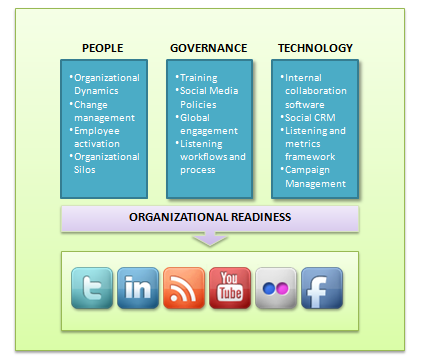
The first pillar deals with the people of the organization. It addresses the need to drive organizational change in an effort to break down organizational silos and get internal teams to communicate. It’s also about activating the organization’s most import assets, its employees.
The second pillar deals with governance. This simply means that organizations need to put processes in place to manage the chaos that exists from behind the firewall. Training, social media guidelines and policies are imperative for organizations to monitor and roll out across the organization within different teams and geographies. It ensures consistency; it protects the organization and at the same time, empowers its employees.
The third and last pillar deals with technology. Organizations have to invest in platforms that facilitate internal collaboration. This is essential to ensure proper communication. External campaign management tools like Sprinklr are also essential to scale, especially if an organization has multiple Facebook and Twitter accounts.
Social CRM plays a significant role within this pillar. My definition of social CRM is that it’s just one component that helps organizations fully evolve into a social business. It’s a strategic business initiative that considers technology, intelligence and process; so when organizations communicate with their customers they know what to say, how to say it and when to say it in order to provide a more relevant customer interaction.
What’s not visible to most, unless you’ve worked in the enterprise, is the anarchy, conflict, confusion, lack of communication and organizational silos that exist behind the firewall. This makes the process of becoming a social brand much more difficult and less effective. So this quest to become a social brand and a social business is one of simultaneous effort.
The conversation is happening.
A study back in 2008 showed that 55% of consumers want ongoing conversations with companies and brands. The study investigated how brands and consumers interact and how consumers want brands to engage with them. And the results were awesome.In addition to the 55% of people wanting an ongoing interaction, 89% of respondents said they would feel more loyal to a brand if they were invited to take part in a feedback group.
A more recent study in 2009 (you can download here) found that 85% of Americans using social media think companies should have an active presence in the social media universe.
What’s even more interesting is that those users actually want interaction with these brands. Here are some other data points you might find useful:
Out of the 85% of people who want companies to be present in social media:
- 34% want companies to actively interact with them
- 51% want companies to interact with them as needed or by request
- 8% think companies should only be passively involved on social media
- 7% think companies should not be involved at all
Has your organization evolved into a social business? Please give us some examples in the comments box below.http://www.socialmediaexaminer.com/the-3-pillars-of-social-media-readiness/
Monday, November 29, 2010
The Resurrection of R&B by @AUTHENTICDRU
The Resurrection of R&B
http://www.blogger.com/post-create.g?blogID=1866229265610925441
Hello All...It has been a while since I've written anything. Clearly There wasn't anything to write about until I start looking at the slow but strong return to R&B.
In this day and age, I've paid close attention to the music this year. Each genre has evolved into some next level, astronomical sound that is to this day, ahead of our time.
It has been a ongoing battle of whether Hip Hop has died or not. The element of hip hop, lyricism, has showed a decrease. But it has not fully died. If anything, After seeing Kanye West Masterpiece "Runaway", I've actually saw what hip hop look in as if it was art. The Essence of what was once a creative way of expressing urban freedom has showed redemption in that 27 mini film.
But did we forget about R&B?
I've Made a mental statement about Trey Songz Latest Single "Can't Be Friends"... The Essence of R&B has Returned. The foundation of that song brought the RHYTHM AND BLUES, the emotion of SOUL, the rawness of the REAL LYRICS BACK! Now I will say that his album "Passion, Pain, and Pleasure" is a "Confessions" of a fresher generation, but in that particular song, Trey made sure YOU was gonna think back to a time where you love someone so deep that friendship even in the future was not going to happen. (Good Sex and Outstanding Love can do that...trust me)
Trey is one of the R&B artist that is keeping the realness alive...but is NOT part of a resurrection. I'm not saying ANYTHING bad for this very reason: He is SELLING and is following "The O'Jays Rule" (Giving the People What They Want)
Hello All...It has been a while since I've written anything. Clearly There wasn't anything to write about until I start looking at the slow but strong return to R&B.
In this day and age, I've paid close attention to the music this year. Each genre has evolved into some next level, astronomical sound that is to this day, ahead of our time.
It has been a ongoing battle of whether Hip Hop has died or not. The element of hip hop, lyricism, has showed a decrease. But it has not fully died. If anything, After seeing Kanye West Masterpiece "Runaway", I've actually saw what hip hop look in as if it was art. The Essence of what was once a creative way of expressing urban freedom has showed redemption in that 27 mini film.
But did we forget about R&B?
I've Made a mental statement about Trey Songz Latest Single "Can't Be Friends"... The Essence of R&B has Returned. The foundation of that song brought the RHYTHM AND BLUES, the emotion of SOUL, the rawness of the REAL LYRICS BACK! Now I will say that his album "Passion, Pain, and Pleasure" is a "Confessions" of a fresher generation, but in that particular song, Trey made sure YOU was gonna think back to a time where you love someone so deep that friendship even in the future was not going to happen. (Good Sex and Outstanding Love can do that...trust me)
Trey is one of the R&B artist that is keeping the realness alive...but is NOT part of a resurrection. I'm not saying ANYTHING bad for this very reason: He is SELLING and is following "The O'Jays Rule" (Giving the People What They Want)
I'm talking about the Resurrection of Artists who were at the peak but somehow let inner demons because the vice of further success. and here are two best examples

K-Ci & JoJo
When I 1st heard of the Reality Series " K-Ci & JoJo Come Clean", It put me back in the place where I would listen to the "Love Always" Album when it came out in 1997.
Two years Later would be the "It's Real" album. Years to come would be a slow decline until I've seen video footage of JoJo having blackout seizure from withdrawal from liquor. I Never Knew that there was an addiction, let alone a 20 year addiction, of alcohol that has been the result of an almost musical demise. I've watch the show faithfully because like anyone else, I wanted to see if this was for real or just to create a buzz of getting back out there...and its the latter. However, I've seen progress by them fighting that addiction. I hear some call them has been, but one episode showed me there is light at the end of the tunnel (I suggest you watch it).
It was when K-Ci went up to the pulpit of his family church and he sung a quick hymn. In his trademark gospel raspy tenor, he belted out those notes not missing a step. So the question is Can the brothers make the return triumphant by making a first ever sober album? There are no other word to say it. I mean Mary J. Blige made some sober albums...she still selling.
The 2nd artist that comes to mind is answering that question but he succeed in defeating the demon of crack and not allowing it to destroy the gift.
Two years Later would be the "It's Real" album. Years to come would be a slow decline until I've seen video footage of JoJo having blackout seizure from withdrawal from liquor. I Never Knew that there was an addiction, let alone a 20 year addiction, of alcohol that has been the result of an almost musical demise. I've watch the show faithfully because like anyone else, I wanted to see if this was for real or just to create a buzz of getting back out there...and its the latter. However, I've seen progress by them fighting that addiction. I hear some call them has been, but one episode showed me there is light at the end of the tunnel (I suggest you watch it).
It was when K-Ci went up to the pulpit of his family church and he sung a quick hymn. In his trademark gospel raspy tenor, he belted out those notes not missing a step. So the question is Can the brothers make the return triumphant by making a first ever sober album? There are no other word to say it. I mean Mary J. Blige made some sober albums...she still selling.
The 2nd artist that comes to mind is answering that question but he succeed in defeating the demon of crack and not allowing it to destroy the gift.

El DeBarge
I thought when younger brother Chico moved to Chicago, HE would make the return but for Eldra Patrick DeBarge, I'm still in amazement when he made his return on the 2010 BET Awards. The Falsetto singer who brought back light skinned (Gotta Problem? lol) made he 1st record in close to 20 years "Second Chance" the Title track spoke in volume. he is proving to the world, like most people who only expect just bad because they are going through trials themselves, that redemption is for ALL. his next single with Faith Evans sound promising, but the question that comes to mind is..WILL IT SELL?
I have an honorary mention:
I have an honorary mention:
 Ronald Isley
Ronald Isley Close to 60 Years in the business, He still putting out albums. Nothing can stop him.
His Age (69),
Being fresh out of prison (Tax Evasion)
The current passing of his baby brother, Marvin (Due to Diabetes Complications)
Mini Stroke (in 2006 while in London)
For this ONE Reason...There was an actually 6th Isley Brother by the name of Vernon. When Vernon was killed in a car accident at the age of 13 or 14, the Matriarch of the Isley family told Ron to Keep the Isley sound alive.
After seeing my Twitter family go clean in talking about he needs to hang it up...
I'm thinking... The Return of these artist came right on time...
I believe something was missing from R&B...
It was something major that made current artists like Trey work more hard to add more to what we already hearing on the radio and Ipod,
Just "(R)eal (&) (B)eautiful Music (R&B)"...
Sunday, November 28, 2010
Skype Video Chat Coming to Facebook?
Skype Video Chat Coming to Facebook?
Do you like this story?
 Even before Skype revealed a deep Facebook integration last month, there was speculation that Facebook might add Skype video chat functionality within the social networking site.
Even before Skype revealed a deep Facebook integration last month, there was speculation that Facebook might add Skype video chat functionality within the social networking site.Although that hasn’t happened yet, Facebook application developer Tal Ater has rekindled speculation around the idea in spotting a “VideoChat” object in Facebook’s code.
Interestingly enough, the code has several properties that refer to Skype and Skype user IDs. Ater also postulates that Facebook is testing the feature with a select group of users as the code doesn’t appear every time the page is loaded.
In some ways, Skype’s Facebook integration — which includes a Facebook tab that enables users to chat, SMS or call their Facebook friends on Skype — only left Facebook users wondering when Facebook integration with Skype video chat might arrive. But with the code referencing Skype user IDs, it might suggest that Facebook is building its own video chat that enables Facebook users to also video chat with their Skype contacts.
After all, Facebook’s new messaging system is an attempt to make communication more seamless and synchronized across multiple platforms. It may very well be that video chat will be added to the mix or that Facebook is at least considering a Skype integration. However, similar code was spotted all the way back in May 2009 and Facebook responded by saying they were testing such a feature but had no plans to launch it to users. The question of Facebook and video chat functionality seems less of an “if,” but more of a “when.”

Subscribe to:
Comments (Atom)
































